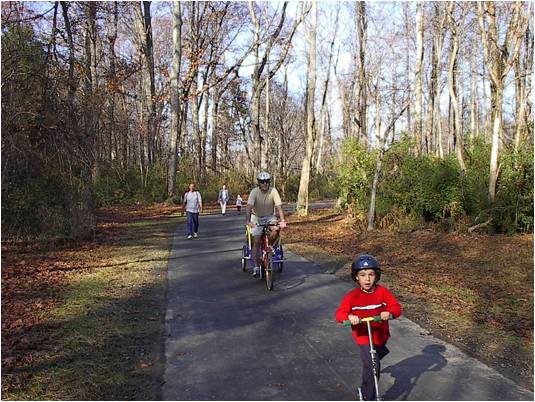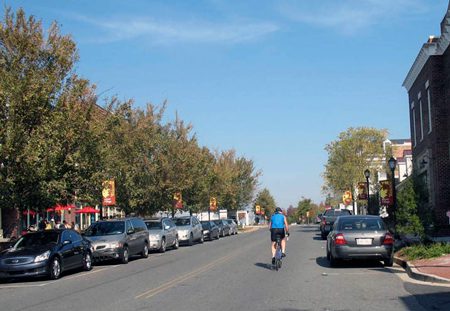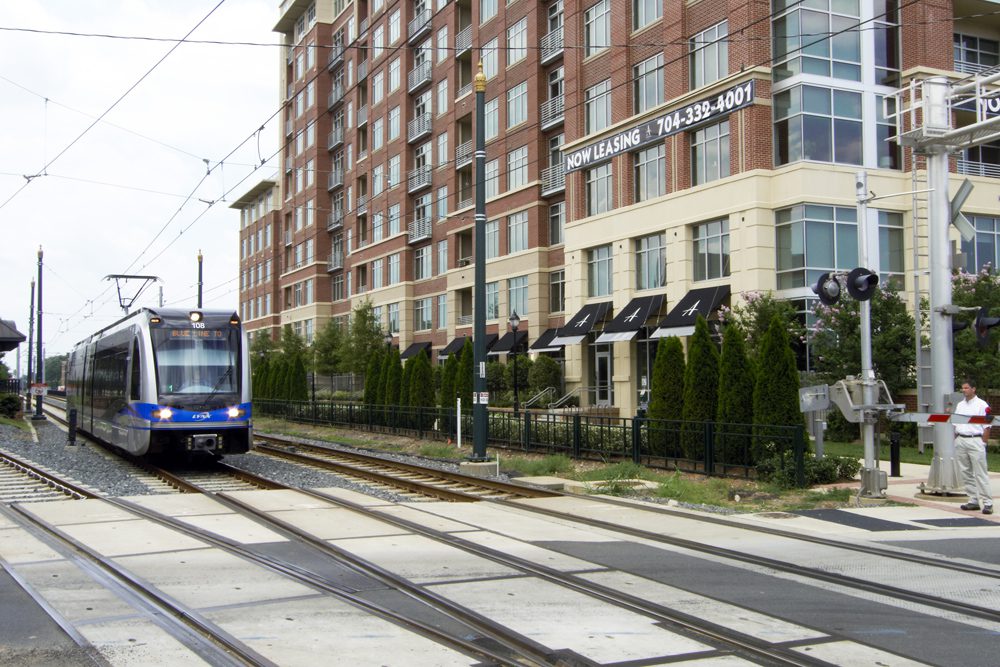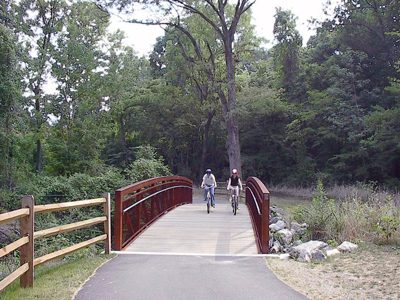No, greenways are not a U.N. conspiracy

There I was, pencil poised over a large drawing of Gastonia. It was 1997 and I was running a public workshop to design a network of greenways and open spaces for residents to enjoy as recreational and natural amenities. Someone in the background was fiddling with a radio. Then, as I remember the moment, the strident sounds of a local radio station blared through the room.
“Did you know there’s a foreigner working in Gastonia, helping the United Nations send troops to take away your freedom?” I recall an angry voice questioning.
We all looked up from the drawing table with a collective “Huh?”
“There’s a little professor from UNC-C working on something called a ‘greenway plan,’ ” the voice continued. “It’s all part of an anti-American plot to invade and take over the country!”
Our little group couldn’t quite believe what we were hearing. The radio voice was obviously talking about us, but what on earth was this gibberish about United Nations troops and invasion?
“I’ve seen their plans,” the voice continued. “Those greenways all go past the backs of your houses; they ain’t nothing but places where the troops can sneak up on you from the back when you ain’t looking. And those big green areas they label ‘open space’? You know what they are? Those are the landing fields for the black helicopters!”
By this time we were laughing fit to burst. Was this a university colleague playing a prank?
Or was it some weird conspiracy theorist, conjuring fantasy plots from our innocent activities? It was indeed. A local talk show host was convinced America was under threat from the “world order” set forth in the U.N.’s Agenda 21.
 As an urban design professional, I was aware of Agenda 21, a technical document dating from 1992 on environmental resource management and development patterns across the globe. In its preamble, the document describes the challenges of widespread poverty, hunger, ill health and illiteracy, and the continuing deterioration of ecosystems upon which human life depends. It makes the obvious point that these problems don’t follow neat boundaries between states and jurisdictions, and that coordinated remedial action built on collaboration and partnership among nations must be taken.
As an urban design professional, I was aware of Agenda 21, a technical document dating from 1992 on environmental resource management and development patterns across the globe. In its preamble, the document describes the challenges of widespread poverty, hunger, ill health and illiteracy, and the continuing deterioration of ecosystems upon which human life depends. It makes the obvious point that these problems don’t follow neat boundaries between states and jurisdictions, and that coordinated remedial action built on collaboration and partnership among nations must be taken.
I had never conceptualized the Gaston County greenways as anything other than a commonsense plan to preserve and enhance environmental corridors for recreation and local transportation. For that to be part of an anti-American agenda was absurd. I couldn’t take the rantings seriously. What was next? Space aliens?
But how America’s political landscape has changed in the past 15 years. What began as extremists so far to the right of the political spectrum that they fell off the edge of reasoned discourse has become mainstream ideology for an increasing number of U.S. politicians and their uncritical followers. Apparently, it’s now the official policy of the Republican Party.
At a national level, Republican presidential candidates spout nonsense about Agenda 21. Newt Gingrich and others have publically declared war on sustainable development at the behest of their impassioned Tea Party supporters, raising the specter of Agenda 21’s sensible principles of development as an attack on what they consider fundamental American values, specified as “private property ownership, single-family homes, private car ownership and individual travel choices.” This conveniently avoids other options valued equally by millions of Americans for different choices of housing, a wider variety of ways to move about, and more options for less wasteful lifestyles.
Undeterred by factual reality, the Republican National Committee (RNC), on Jan. 13 adopted a resolution “exposing” Agenda 21 as an assault on America. Specifically, the RNC attacked “sustainable development policies such as Smart Growth, Wildlands Project, Resilient Cities, Regional Visioning Projects, and other ‘Green’ or ‘Alternative’ projects.”
The RNC goes further, suggesting that the supposed anti-Americanism of sustainable development is being covertly infiltrated into branches of American government at all levels and that any initiatives for sustainable development and smart growth should be rejected and defunded at every level, in order to protect America.
So there we have it. Policies designed to fight future problems of pollution, congestion, environmental damage and declining public health that threaten the economic prosperity of American cities and the quality of life of most Americans are hereby redefined as anti-American.
Clearly, a large section of the American public and part of the political class now lives in an alternative reality where up is down and black is white. Logic has no place. Facts are irrelevant.
The rapid contagion of this anti-intellectual virus, spread anew through the Tea Party’s ideology about the evils of almost any form of government, is well documented in pro- and anti- blogs online and on the Feb. 4 New York Times front page.
In this paranoid universe, public transit, streetcars, light rail and other useful modes of movement in cities are viewed as “European socialism,” intended to strip Americans of their cars and force them to live in high-density towers.
Try pointing out that the prime movers behind higher-density living are often conservatives: developers legitimately making money by following market forces and the changing demographic preferences of parts of the American public. Try pointing out that eliminating public transit reduces individual travel choices. The blinders are on; critical faculties are switched off.
 It’s tragically fitting that the fringe madness about Agenda 21 and fantasies about U.N. troops sneaking up greenways to take over Gastonia for the New World Order that I encountered 15 years ago have officially re-emerged in our neighboring county. At their Jan. 26 meeting, all seven Gaston County commissioners resolved to warn all communities against the evils of Agenda 21 and sustainable development, which they view as a “Marxist weapon” in a plot for political control of the country by the United Nations.
It’s tragically fitting that the fringe madness about Agenda 21 and fantasies about U.N. troops sneaking up greenways to take over Gastonia for the New World Order that I encountered 15 years ago have officially re-emerged in our neighboring county. At their Jan. 26 meeting, all seven Gaston County commissioners resolved to warn all communities against the evils of Agenda 21 and sustainable development, which they view as a “Marxist weapon” in a plot for political control of the country by the United Nations.
This officially backed bunkum could not resurface at a worse time as we emerge from a recession and need to recalibrate our future policies so as not to repeat the mistakes of the past. America’s future is very much in the balance: If this is to remain a decent place to live, and to provide world leadership for sustainable development (or even just catch up to our global competitors) designers and planners need to fight hard for sustainable design and planning; for good public transit, safe streets, a clean, healthy environment and economically strong neighborhoods with affordable housing where working folks can live with dignity.
But then I would say that, wouldn’t I? I am, after all, a European . . . .
Views expressed in this commentary are those of the author and do not necessarily represent the views of the UNC Charlotte Urban Institute, its staff, or the University of North Carolina at Charlotte.
Photo credits: Baxter Town Center and South End apartments by David Walters. Avon/Catawba Creek Greenway courtesy Carolina Thread Trail.